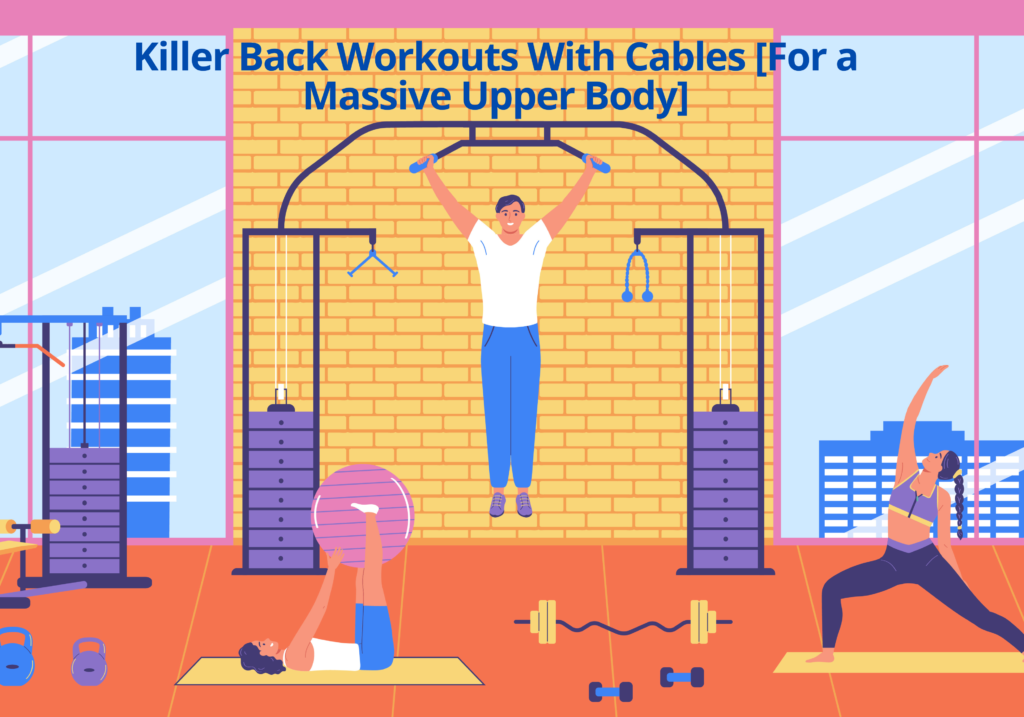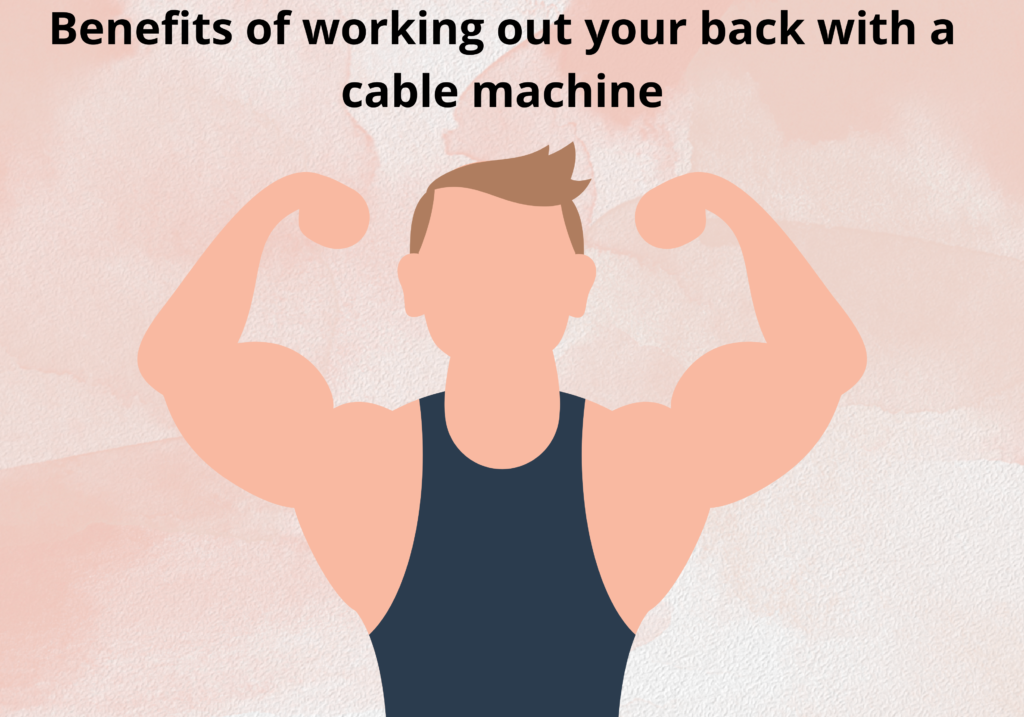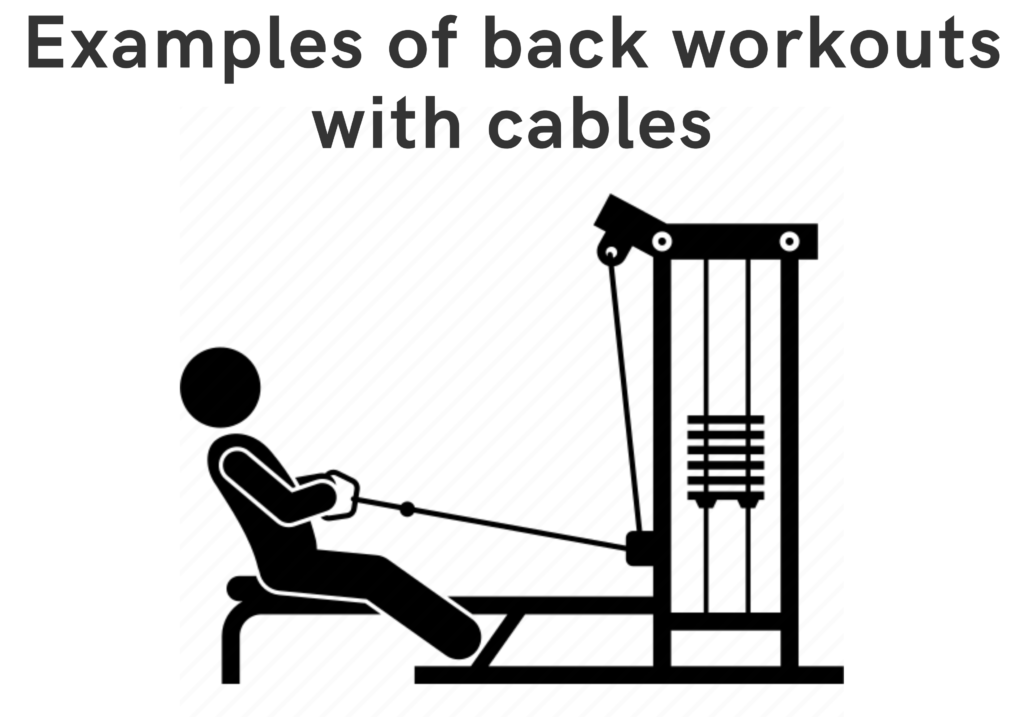
Cable back workouts are an excellent way to build strength and mass in the upper body. These exercises utilize a cable machine, which allows for a greater range of motion and helps target specific muscle groups. The resistance provided by the cable machine can also help to improve stability and posture. Here are some of the best cable back workouts for a massive upper body:
Cable Pull-Downs
This exercise is a classic cable back workout that targets the latissimus dorsi (lats) and the trapezius muscles. To perform a cable pull-down, start by adjusting the cable height to the upper chest and grasping the cable bar with a wide grip. Pull the bar down towards your chest while keeping your elbows tucked in. Slowly return to the starting position and repeat.
Cable Rows
Cable rows are another great cable back workout that targets the middle and upper back muscles, including the rhomboids and the teres major. To perform a cable row, stand facing the cable machine and grip the handle with both hands. Keep your back straight and pull the handle towards your torso, squeezing your shoulder blades together. Return to the starting position and repeat.
Cable Seated Reverse Fly
This exercise focuses on the posterior deltoids and the rotator cuff muscles. To perform a cable seated reverse fly, sit on a bench facing the cable machine and grasp the handle with both hands. Keeping your arms straight, pull the handle out to the sides and away from your body, keeping your arms at the same level. Return to the starting position and repeat.
Cable Lat Pullovers
This cable back workout targets the lats and the chest muscles. To perform a cable lat pullover, lie down on a bench and grip the cable handle with both hands. Keeping your arms straight, pull the handle over your head and then back to the starting position.
In conclusion, cable back workouts are an excellent way to target specific muscle groups in the upper body and build strength and mass. Incorporating these exercises into your workout routine can help to improve posture and stability while also helping to sculpt a massive upper body. Remember to always use proper form and technique, and start with a light weight before gradually increasing the resistance.
Benefits of working out your back with a cable machine

Cable back workouts offer a range of benefits for those looking to strengthen and tone their upper body. The cable machine provides a unique form of resistance that can be adjusted to target specific muscle groups, making it a versatile and effective tool for back workouts. Here are some of the key benefits of cable back workouts:
Improved posture
Cable back workouts help to build strength in the upper back muscles, which are crucial for maintaining good posture. By working on these muscles, you can improve your posture and reduce the risk of back pain and injury.
Targeted resistance
Cable machines allow for targeted resistance, meaning that you can focus on specific muscle groups to maximize their development. This is particularly useful for back workouts, as the cable machine can help you isolate and target the muscles of the upper back.
Increased range of motion
Cable back workouts often require a greater range of motion compared to traditional weightlifting exercises, which can help to improve flexibility and mobility. This can also help to prevent injury by reducing the risk of muscle imbalances and tightness.
Enhanced stability
Cable back workouts involve a constant tension on the muscles, which helps to improve stability and balance. This can be particularly useful for athletes and those looking to improve their performance in other sports and activities.
Reduced risk of injury
Cable back workouts can be performed with a lighter weight, which reduces the risk of injury. The constant tension provided by the cable machine also helps to reduce the risk of muscle strains and sprains.
In conclusion, cable back workouts offer a range of benefits for those looking to build strength and tone their upper body. With the ability to target specific muscle groups and improve posture, stability, and range of motion, cable back workouts are a versatile and effective tool for achieving your fitness goals. Remember to always use proper form and technique and start with a light weight before gradually increasing the resistance.
Cable machines vs. free weights for back workouts
When it comes to back workouts, many fitness enthusiasts face a dilemma of whether to use cable machines or free weights. Both have their advantages and disadvantages, and the choice between the two often comes down to personal preference and fitness goals. Here’s a comparison of cable back workouts and free weights for back exercises:
Range of motion
Cable back workouts offer a greater range of motion compared to free weights. The cable machine allows for continuous tension on the muscles throughout the entire range of motion, which can help to increase flexibility and mobility. On the other hand, free weights have a limited range of motion and can cause muscle imbalances and tightness if not performed correctly.
Targeted resistance
Cable back workouts offer targeted resistance, meaning that you can focus on specific muscle groups to maximize their development. This is particularly useful for back workouts, as the cable machine can help you isolate and target the muscles of the upper back. Free weights, on the other hand, provide a more general form of resistance that can be difficult to control, particularly for those who are new to weightlifting.
Ease of use
Cable back workouts are generally considered to be easier to perform than free weights, as they require less balance and stability. This makes them a great choice for beginners or those who are rehabilitating from an injury. Free weights, on the other hand, require a greater level of balance and stability, which can make them more challenging to perform.
Cost
Cable back workouts can be performed using a cable machine, which can be expensive to purchase or access at a gym. Free weights, on the other hand, are relatively inexpensive and can be used at home or at the gym.
In conclusion, both cable back workouts and free weights have their advantages and disadvantages. Cable machines offer a greater range of motion and targeted resistance, making them a great choice for those looking to increase flexibility and mobility. Free weights, on the other hand, are generally considered to be more challenging and require a greater level of balance and stability. Ultimately, the choice between the two often comes down to personal preference and fitness goals.
7 Back exercises with cables: beginner to advanced
Cable back workouts are a great way to target the muscles of the upper back and build strength and definition. Here are seven back exercises with cables that range from beginner to advanced levels:
Cable row
The cable row is a great exercise for beginners, as it requires minimal balance and stability. Stand facing the cable machine with your feet hip-width apart and grasp the handle with both hands. Pull the handle towards your chest, keeping your elbows close to your body. Repeat for 8-12 repetitions.
Seated cable row
The seated cable row is a more advanced version of the cable row, and it targets the muscles of the upper back more effectively. Sit facing the cable machine with your feet flat on the floor and grasp the handle with both hands. Pull the handle towards your chest, keeping your back straight and your elbows close to your body. Repeat for 8-12 repetitions.
Lat pulldown
The lat pulldown is a great exercise for targeting the latissimus dorsi, which is the largest muscle in the back. Stand facing the cable machine and grasp the bar with both hands, keeping your palms facing away from your body. Pull the bar down towards your chest, keeping your back straight and your elbows close to your body. Repeat for 8-12 repetitions.
One-arm cable row
The one-arm cable row is an advanced exercise that requires greater balance and stability. Stand facing the cable machine with one hand grasping the handle and the other hand resting on a support. Pull the handle towards your chest, keeping your elbow close to your body. Repeat for 8-12 repetitions on each arm.
Cable reverse fly
The cable reverse fly is a great exercise for targeting the muscles of the upper back and improving posture. Stand facing away from the cable machine with your feet hip-width apart and grasp the handle with both hands. Pull the handle out to the sides, keeping your arms straight and your back straight. Repeat for 8-12 repetitions.
Cable pullover
The cable pullover is a great exercise for targeting the muscles of the upper back, chest, and triceps. Stand facing away from the cable machine with your feet hip-width apart and grasp the handle with both hands. Pull the handle over your head, keeping your arms straight and your back straight. Repeat for 8-12 repetitions.
Cable twisting row
The cable twisting row is an advanced exercise that requires greater balance and stability. Stand facing the cable machine with your feet hip-width apart and grasp the handle with both hands. Pull the handle towards your chest, twisting your torso as you do so. Repeat for 8-12 repetitions on each side.
In conclusion, cable back workouts are a great way to build strength and tone the muscles of the upper back. These seven exercises range from beginner to advanced levels and can be performed using a cable machine. Always use proper form and technique and start with a light weight before gradually increasing the resistance.
Examples of back workouts with cables

Cable back workouts are an effective way to target and strengthen the muscles of the upper back. Here are some examples of back workouts with cables:
Beginner cable back workout
Technique
For a beginner-friendly cable back workout, start with a cable row. Stand facing the cable machine with your feet hip-width apart and grasp the handle with both hands. Pull the handle towards your chest, keeping your elbows close to your body. Repeat for 8-12 repetitions. Next, perform a seated cable row. Sit facing the cable machine with your feet flat on the floor and grasp the handle with both hands. Pull the handle towards your chest, keeping your back straight and your elbows close to your body. Repeat for 8-12 repetitions. Finish with a cable reverse fly. Stand facing away from the cable machine with your feet hip-width apart and grasp the handle with both hands. Pull the handle out to the sides, keeping your arms straight and your back straight. Repeat for 8-12 repetitions.
Intermediate cable back workout
Technique
For an intermediate cable back workout, start with a lat pulldown. Stand facing the cable machine and grasp the bar with both hands, keeping your palms facing away from your body. Pull the bar down towards your chest, keeping your back straight and your elbows close to your body. Repeat for 8-12 repetitions. Next, perform a one-arm cable row. Stand facing the cable machine with one hand grasping the handle and the other hand resting on a support. Pull the handle towards your chest, keeping your elbow close to your body. Repeat for 8-12 repetitions on each arm. Finish with a cable pullover. Stand facing away from the cable machine with your feet hip-width apart and grasp the handle with both hands. Pull the handle over your head, keeping your arms straight and your back straight. Repeat for 8-12 repetitions.
Advanced cable back workout
Technique
For an advanced cable back workout, start with a cable twisting row. Stand facing the cable machine with your feet hip-width apart and grasp the handle with both hands. Pull the handle towards your chest, twisting your torso as you do so. Repeat for 8-12 repetitions on each side. Next, perform a cable reverse fly with a twist. Stand facing away from the cable machine with your feet hip-width apart and grasp the handle with both hands. Pull the handle out to the sides, twisting your torso as you do so. Repeat for 8-12 repetitions. Finish with a cable pullover with a twist. Stand facing away from the cable machine with your feet hip-width apart and grasp the handle with both hands. Pull the handle over your head, twisting your torso as you do so. Repeat for 8-12 repetitions.
In conclusion, cable back workouts are a great way to target and strengthen the muscles of the upper back. These examples range from beginner to advanced levels and can be performed using a cable machine. Always use proper form and technique and start with a light weight before gradually increasing the resistance.
Final words
Cable back workouts are a valuable addition to any strength training routine, as they offer a variety of benefits for the upper back muscles. By using a cable machine, you can target these muscles from different angles, providing a comprehensive workout that promotes strength, stability, and flexibility.
It is important to remember that proper form and technique are key when performing cable back workouts. Incorrect form can lead to injury, so make sure to start with a light weight and gradually increase the resistance as you get comfortable with the exercises. Additionally, it’s important to warm up before starting your cable back workout and to stretch your back muscles afterwards to help prevent injury and promote flexibility.
Cable back workouts can be tailored to meet the needs of individuals at all fitness levels, from beginners to advanced athletes. Whether you are looking to improve your posture, build strength, or target specific muscles, cable back workouts can help you achieve your goals.
In conclusion, cable back workouts are a versatile and effective way to target the upper back muscles. By using proper form and technique, and incorporating cable back workouts into your strength training routine, you can experience improved posture, increased strength, and reduced risk of injury. So why not give cable back workouts a try and see the results for yourself?